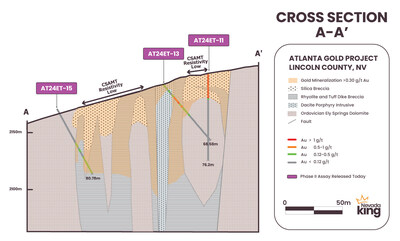NEVADA KING MAKES AT-SURFACE OXIDE GOLD DISCOVERY AT EAST RIDGE ZONE, SHOWS POTENTIAL FOR LARGER MINERALIZED TARGETS IN NEW GEOLOGICAL SETTING AT ATLANTA
Rhea-AI Summary
Nevada King Gold Corp. (TSXV: NKG) (OTCQX: NKGFF) has announced a new at-surface oxide gold discovery at the East Ridge Zone (ERZ) of its Atlanta Gold Mine Project in Nevada. Key highlights include:
- Intercept of 1.32 g/t Au over 22.9m in hole AT24ET-11
- Gold mineralization found in 5 widely spaced holes over a 100m x 200m area
- Mineralization hosted in silica breccia and intrusive rock, open to 57m depth
- ERZ represents the first satellite gold discovery at Atlanta, demonstrating district-scale potential
- Discovery based on geophysical anomaly, opening up numerous additional target areas
The company is now testing extensions of the ERZ along the geophysical anomaly and exploring for depth and width of mineralization.
Positive
- Discovery of new at-surface oxide gold zone (ERZ) with intercept of 1.32 g/t Au over 22.9m
- Gold mineralization found in 5 holes over 100m x 200m area, open to 57m depth
- First satellite gold discovery at Atlanta, demonstrating district-scale potential
- Geophysics-based discovery opens up numerous additional target areas
- New geological setting differs from main resource zone, suggesting potential for multiple gold zones
Negative
- None.
News Market Reaction 1 Alert
On the day this news was published, NKGFF gained 1.53%, reflecting a mild positive market reaction.
Data tracked by StockTitan Argus on the day of publication.
Highlights:
- First pass drilling at the ERT has led to the discovery of an at-surface oxide gold zone called the East Ridge Zone ("ERZ") that is located within the overall ERT area and includes the highlight interval of 1.32 g/t Au over 22.9m in AT24ET-11 (Figure 1). Gold mineralization was intercepted in five of today's widely spaced holes over a 100m x 200m area, with mineralization hosted in silica breccia and mineralized intrusive rock down to a depth of 57m where it remains open (Figure 2). The ERZ represents the first satellite gold discovery made at
Atlanta and demonstrates the project's district-scale potential.
Hole No. | From (m) | To (m) | Interval (m) | Au (g/t) | Ag (g/t) |
AT24ET-11 | 0 | 22.9 | 22.9 | 1.32 | 3.5 |
AT24ET-12^ | 0 | 22.9 | 22.9 | 0.33 | >1.0 |
AT24ET-13^ | 12.2 | 33.5 | 21.3 | 0.53 | 2.35 |
AT24ET-14 | 6.1 | 12.2 | 6.1 | 0.36 | 1.3 |
AT24ET-15^ | 42.7 | 79.3 | 36.6 | 0.16 | 1.7 |
Table 1. Highlight holes released today. True mineralized thickness estimated to be |
- Referring to Figures 3-4, the mineralized intercepts in today's holes correlate well with the low resistivity zone from the Company's CSAMT geophysical survey that outlines near-vertical bodies of low resistivity, interpreted as mineralized high-angle intrusions (shown in red) cutting up through a highly resistive, unmineralized dolomite sequence (shown in blue). Ten vertical reconnaissance holes (AT23ET-1-AT23ET-10) arranged along a north-south line between the ERT and the
Atlanta resource zone were designed to check for a possible low-angle connection between both mineralized zones. All ten holes were sited within the high resistance zone separating the ERT and resource zone, and the lack of significant gold values in these holes further supports the Company's CSAMT interpretation above. - Each of today's five highlight holes intercepted high-angle, intrusive-related gold mineralization bounded laterally by massive, impermeable dolomite. This geological setting differs substantially from that seen in the
Atlanta resource zone, where gold occurs along and immediately above a low-angle unconformity separating dolomitic and quartzitic basement rocks from overlying volcanic rocks. The new geological setting seen at the ERT lends itself to numerous additional targets identified by the CSAMT data throughout theAtlanta district, including the much larger Jumbo Target located a further 300m east of the ERT, which measures 400m wide by 3,000m north-south (Figure 5). - Current drilling is testing the northern and southern extensions of the ERZ along the geophysical anomaly as well as for depth and width of mineralization. A full technical discussion detailing today's holes and their significance can be found in the Technical Discussion section below.
Cal Herron, Exploration Manager of
"By comparing the past and present drill hole locations to the inferred intrusive pattern found in our CSAMT data (Figure 5), it is clear that very little of this prospective ground has been drill-tested. As our 2024 reconnaissance exploration program progresses, we now have numerous targets to chase in all directions from the current resource zone, and considering the strong intrusive tie to Au/Ag mineralization, the Company is well positioned to make more new discoveries."
Hole No. | From (m) | To (m) | Interval (m) | Au (g/t) | Ag (g/t) |
AT23ET-1 | 0 | 4.6 | 4.6 | 0.29 | 1.1 |
AT23ET-2 | 0 | 59.5 | 59.5 | <0.04 | <0.5 |
AT23ET-3 | 0 | 6.1 | 6.1 | 0.14 | 0.675 |
AT23ET-4 | 1.5 | 3.0 | 1.5 | 0.10 | <0.5 |
AT23ET-5 | 0 | 61.0 | 61.0 | <0.04 | <0.5 |
AT23ET-6 | 13.7 | 15.2 | 1.5 | 0.13 | <0.5 |
AT23ET-7 | 27.4 | 29.0 | 1.5 | 0.10 | <0.5 |
AT23ET-8 | 0 | 77.7 | 77.7 | <0.04 | <0.5 |
AT23ET-9 | 0 | 111.3 | 111.3 | <0.04 | <0.5 |
AT23ET-10^ | 10.7 | 35.1 | 24.4 | 0.05 | <0.5 |
AT24ET-11 | 0 | 22.9 | 22.9 | 1.32 | 3.5 |
AT24ET-12^ | 0 | 22.9 | 22.9 | 0.33 | >1.0 |
AT24ET-13^ | 12.2 | 33.5 | 21.3 | 0.53 | 2.35 |
AT24ET-14 | 6.1 | 12.2 | 6.1 | 0.36 | 1.3 |
AT24ET-15^ | 42.7 | 79.3 | 36.6 | 0.16 | 1.7 |
Table 2. All holes released today. True mineralized thickness estimated to be 95 |
Technical Discussion
- As seen in Figure 2, higher grade Au mineralization is hosted in silica breccia adjacent to intrusive dikes and within strongly silicified rhyolitic tuff dike breccia zones hosting small quartz veinlets, while lower grade mineralization occurs within argillized tuff dikes and variably silicified dolomite.
- Vertical hole AT24ET-11 (1.32 g/t Au over 22.9m) and angle hole AT24ET-12 (0.33 g/t over 22.9m) were collared along the eastern margin of the CSAMT anomaly. Both holes encountered mineralization at the surface that extend to 23m depth, where Au values dropped quickly when the massive dolomite bounding the eastern side of the intrusive zone was penetrated.
- Angle hole AT24ET-13 collared in a weakly mineralized dacite tuff dike (average 0.176 g/t Au over 15.2m) and encountered higher-grade mineralization (0.53 g/t over 21.3m) within a silicified rhyolite tuff dike breccia and adjacent silicified/decalcified dolomite from 15.2m to 33.5m (10.7m and 23.7m vertical depths). Gold values drop rapidly with depth in the adjacent massive dolomite.
- Vertical hole AT24ET-14 (6.1m @ 0.33 g/t Au) tested an argillized dacitic intrusion exposed in the drill road 52m south of AT24ET-11 along the eastern margin of the CSAMT anomaly. Gold enrichment occurs within a rhyolitic tuff dike breccia at 6m depth directly beneath the dacite and decreased rapidly as the hole entered the adjacent massive dolomite bounding the eastern side of the intrusive zone.
- Angle hole AT24ET-15 (36.6m @ 0.164 g/t Au) was sited to test the western margin of the CSAMT anomaly. The hole collared in unmineralized, massive dolomite and hit the mineralized intrusive zone at 41m depth (29m vertical depth). This hole stayed in weakly mineralized rhyolitic tuff dike breccia to the TD depth of 81m (57.2m vertical depth) and bottomed in 0.087 g/t Au. This long gold intercept reveals the presence of mineralized intrusive down to a minimum 57.2m depth, which correlates well with the low resistivity zone forming the ERZ CSAMT anomaly.
- Figure 3 plots the traces of angle holes AT24ET-12 and AT24ET-13 onto a sectional view of the East Ridge CSAMT anomaly along Line 10. AT24ET-13 clearly correlates the altered, mineralized igneous intrusions and associated silicified/decalcified dolomite with the near-vertical low resistivity zone (orange color) forming the CSAMT anomaly. The dark blue highly resistive regions are clearly unaltered and unmineralized massive dolomite that served as a lateral constraint on the mineralization, hence concentrating the gold within a confined space. The paragenesis for gold mineralization in this geologic setting is evident: dacitic intrusions and associated acidic, magmatic fluids originating from a much larger magmatic body at depth stoped upward into the massive dolomite country rock toward the surface along pre-existing faults, decalcifying the adjacent and overlying dolomite in the process and creating a shell of collapse breccia around the intrusive zone. This initial igneous and alteration event was followed by intrusion of more felsic, rhyolitic intrusions and associated gold-rich fluids along the same structural pathways, which resulted in a larger area of collapse brecciation, silicification, and gold mineralization within the intrusive rocks and adjacent collapse breccia.
Evidence for a Porphyry-Related Gold Deposit at
- The term "porphyry-related deposit" refers to a metallic deposit that is genetically associated with a generally deeper, metalliferous, volatile (water and gas) rich magma that rapidly pushes its way up toward the earth's surface and in the process concentrates metals and fluids (mainly water) at and near the top of the magma column. As the magma chills into solid rock, late stage porphyritic dikes together with water containing dissolved metals are injected upward and outward from the cooling igneous stock into surrounding, cooler wallrock and potentially all the way upward to the surface. Upon cooling in a generally lower pressure environment and likely mixing with meteoric water closer to the surface, the metals contained in the hydrothermal fluid precipitate and are deposited in the intrusive dikes and adjacent permeable and possibly reactive wallrock, thus forming a porphyry-related deposit that frequently looks nothing like the parent porphyry deposit. This connection between porphyry-related deposits and a deeper porphyry deposit is important because the parent magma for both deposit types possesses the ability to generate large quantities of heat, water/gas, and metals over a long period of time – all of which are necessary to form large base and precious metals deposits. Such porphyry-related deposits often form in caldera settings (like
Atlanta ) where recurrent intrusive activity within and/or around the caldera margin can produce multiple deposits, ranging from deep porphyry Cu/Mo to surficial hotspring-type gold systems in different parts of the caldera at the same time. With increasing distance from the porphyry source, the related but more distal deposits tend to take on different geological characteristics peculiar to the immediate geologic environment in which they form, but usually some evidence of the porphyry "mother" source is seen in the distal deposits, such as high copper or molybdenum gold deposits that are related to the deeper porphyry copper/molybdenum deposits. Porphyry and porphyry-related metal deposits form a large proportion of global base and precious metals production and are important components in many major mining company's portfolios. TheAtlanta District is a good example of a porphyry-type environment in a caldera setting where intrusive and associated volcanic resurgence occurred over a span over several million years. Drilling within theAtlanta resource zone and along the ERZ has revealed a strong connection between gold/silver mineralization and shallow (subvolcanic) intrusive rocks that most likely originated from porphyry-type sources at depth, as outlined below. - Within the
Atlanta resource zone, volcanic rocks deposited on top of dolomite and quartzite basement rocks formed a gently west-dipping unconformity that served as the primary host for gold mineralization. High-angle faults channeled vesiculated igneous dikes (tuff dikes) and mineralizing fluids up into the unconformity where they spread laterally, and in places like the West Atlanta Graben Zone, moved upward into the volcanic sequence. At the ERZ we find the same high angle, vesicular intrusive bodies and associated gold mineralization, but its structural setting is very different in that dolomite basement rocks laterally bound high-angle, dike-like vesicular intrusions that stoped upward into the carbonate sequence from a magmatic and hydrothermal source at depth. Intrusion of late stage, rhyolitic tuff dikes along this high-angle structural corridor appears to have occurred at the same time as the alteration and gold mineralization, which strongly suggests a genetic relationship between mineralization and the dikes. Even though the structural settings are very different, the very close relationship in time and space between gold mineralization and intrusion of porphyritic, vesicular dacitic and rhyolitic dikes, sills, and small plugs in both the resource zone and ERZ argues strongly for the presence of an intrusive-dominated, porphyry-related gold system. Further evidence is seen in the strong molybdenum mineralization (>1000 ppm Mo) that occurs in and below the gold zone within the West Atlanta Graben Zone together with reported gold tellurides found in silica breccia along the Atlanta Mine Fault Zone. This porphyry tie is further supported by the spatial coincidence of gold-mineralized, shallow intrusions with the deeper, much larger intrusive bodies inferred from the CSAMT data (Figure 5). This structural tie to a deep intrusive body has been drill-verified at the southwestern corner of the resource zone where several deep historical andNevada King holes have drilled into a large, dacite porphyry dike or elongate dome that is also exposed at the surface bounding the Quartzite Ridge Target's western margin. This part of the resource zone is also where the highest molybdenum values occur. The lack of obvious porphyry Cu-Mo indicators, like presence of potassic alteration (K-spar/ biotite) and calc-silicate alteration in the carbonates, tells usAtlanta is still far from any potential porphyry source. Additionally, the Company possesses no isotope or fluid inclusion work to directly verify a porphyry tie at depth. However, the lithologic and mineralogical data, the geophysical data (gravity, drone magnetics, CSAMT), and the deep drill holes at the SW corner of the resource zone all indicate a strong structural tie to a porphyry-type source at depth. We see this same relationship between gold mineralization and shallow rhyolitic intrusions elsewhere in theAtlanta District, most commonly in the Quartzite Ridge Target and Western Knolls Target (4km west of the resource zone), which provides additional evidence for the presence of one or more porphyry intrusions at depth that powered a district-scale hydrothermal system. This shallow porphyry tie to gold mineralization atAtlanta opens up the entire district for finding additional Au deposits. Utilizing our gravity, magnetic, and CSAMT datasets, identification of deep-seated intrusive plumbing underlying theAtlanta District has providedNevada King with a fairly accurate roadmap for pursuing additional porphyry-related targets well outside the current resource zone.
QA/QC Protocols
All RC samples from the Atlanta Project are split at the drill site and placed in cloth and plastic bags utilizing a nominal 2kg sample weight. CRF standards, blanks, and duplicates are inserted into the sample stream on-site on a one-in-twenty sample basis, meaning all three inserts are included in each 20-sample group. Samples are shipped by a local contractor in large sample shipping crates directly to American Assay Lab in
Qualified Person
The scientific and technical information in this news release has been reviewed and approved by Calvin R. Herron, P.Geo., who is a Qualified Person as defined by National Instrument ("NI 43-101").
About Nevada King Gold Corp.
The Atlanta Mine is a historical gold-silver producer with a NI 43-101 compliant pit-constrained resource of 460,000 oz Au in the measured and indicated category (11.0M tonnes at 1.3 g/t) plus an inferred resource of 142,000 oz Au (5.3M tonnes at 0.83 g/t). See the NI 43-101 Technical Report on Resources titled "Atlanta Property,
Resource Category | Tonnes (000s) | Au Grade (ppm) | Contained Au | Ag Grade (ppm) | Contained Ag |
Measured | 4,130 | 1.51 | 200,000 | 14.0 | 1,860,000 |
Indicated | 6,910 | 1.17 | 260,000 | 10.6 | 2,360,000 |
Measured + Indicated | 11,000 | 1.30 | 460,000 | 11.9 | 4,220,000 |
Inferred | 5,310 | 0.83 | 142,000 | 7.3 | 1,240,000 |
Table 3. NI 43-101 Mineral Resources at the Atlanta Mine |
Please see the Company's website at www.nevadaking.ca.
Neither the TSX Venture Exchange nor its Regulation Services Provider (as that term is defined in the policies of the TSX Venture Exchange) accepts responsibility for the adequacy or accuracy of this release.
Cautionary Statements Regarding Forward Looking Information
This news release contains certain "forward-looking information" and "forward-looking statements" (collectively "forward-looking statements") within the meaning of applicable securities legislation. All statements, other than statements of historical fact, included herein, without limitation, statements relating the future operations and activities of
![]() View original content to download multimedia:https://www.prnewswire.com/news-releases/nevada-king-makes-at-surface-oxide-gold-discovery-at-east-ridge-zone-shows-potential-for-larger-mineralized-targets-in-new-geological-setting-at-atlanta-302197828.html
View original content to download multimedia:https://www.prnewswire.com/news-releases/nevada-king-makes-at-surface-oxide-gold-discovery-at-east-ridge-zone-shows-potential-for-larger-mineralized-targets-in-new-geological-setting-at-atlanta-302197828.html
SOURCE Nevada King Gold Corp.














